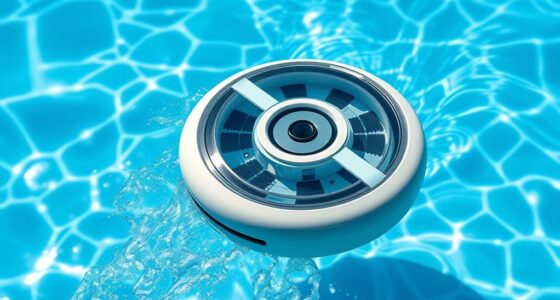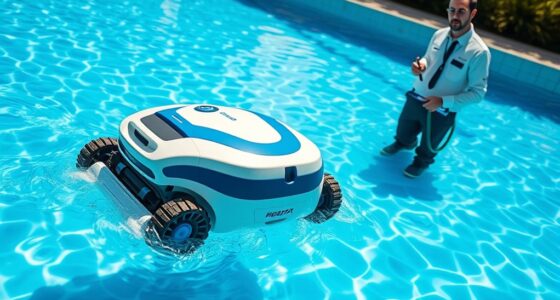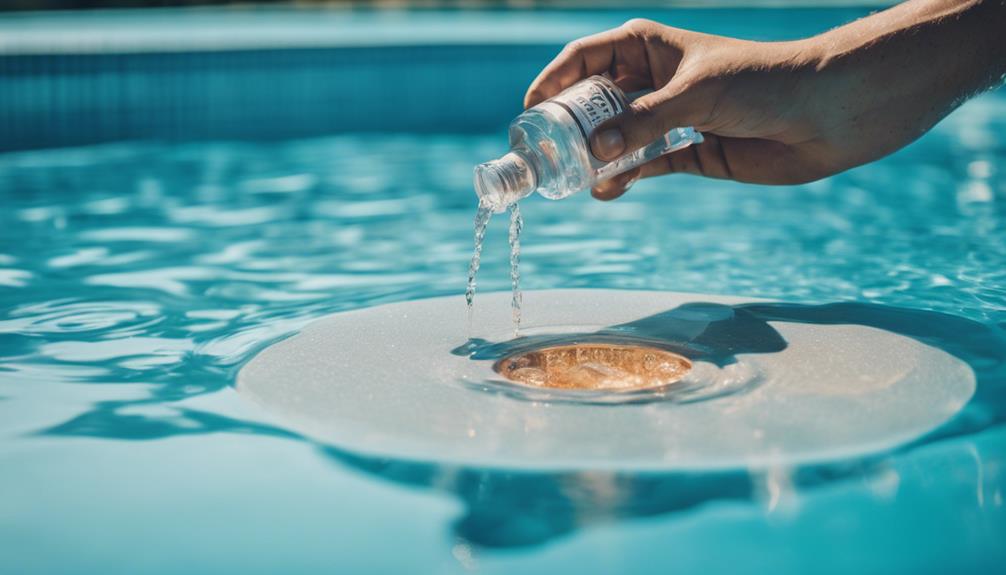To prevent calcium buildup in your swimming pool, it is crucial to maintain proper pH levels between 7.2-7.6 and alkalinity levels between 80-120 ppm. Be sure to regularly test your water and choose shocks with lower calcium content. Consider using clarifiers to assist in removing particles and keeping chemical balance. Improve filtration by using clarifiers, following the manufacturer’s instructions. Adjust the frequency of clarifier use based on pool size and water condition. Keep up with regular pool maintenance, including pH testing, cleaning, and using clarifiers without calcium. Identifying calcium buildup early can help prevent damage.
Key Takeaways
- Maintain proper pH levels (7.2-7.6) to prevent calcium scaling.
- Use low-calcium shocks and clarifiers for filtration.
- Regularly test water chemistry and balance chemicals.
- Consider installing an auto pool cover to reduce evaporation.
- Implement a routine maintenance schedule for prevention.
Importance of Proper Ph Levels
Why is maintaining proper pH levels essential for preventing calcium buildup in your swimming pool?
Proper pH levels, typically between 7.2-7.6, play an important role in keeping your pool water balanced and free from calcium deposits. When your pool's pH levels are imbalanced, it can lead to calcium scaling, which not only affects the aesthetics of your pool but can also damage surfaces and equipment.
To prevent this, it's essential to regularly test and adjust the pH levels of your pool water. Additionally, maintaining the alkalinity levels between 80-120 ppm can further help in preventing calcium buildup.
Another useful step is installing an auto pool cover, which reduces evaporation and minimizes the chances of calcium scaling in your pool. By incorporating these measures into your regular pool maintenance routine, you can effectively prevent calcium deposits and keep your swimming pool in top condition.
Avoiding Calcium-Rich Shocks

When it comes to avoiding calcium-rich shocks in your pool, regular water testing and maintaining proper pH balance are essential.
By opting for shocks with lower calcium content and using a clarifier to assist the filter, you can prevent scale formation and maintain water clarity.
Regular Water Testing
Regularly testing your pool water is crucial in avoiding the use of calcium-rich shocks that can contribute to calcium buildup in your swimming pool. By monitoring calcium levels and pH balance through consistent water testing, you can prevent the need for treatments that introduce additional calcium to the water, ultimately reducing the risk of buildup.
To maintain a healthy pool environment and prevent calcium accumulation, consider the following:
- Frequent Testing: Test your pool water regularly to keep track of calcium levels and pH balance.
- Avoid Calcium Shocks: Stay away from shock treatments containing calcium to prevent adding more calcium to the pool water.
- Maintain Chemical Balance: Guarantee proper chemical balance in your pool to deter calcium buildup.
- Use Clarifiers: Employ a clarifier to aid the filter in removing calcium particles from the water, helping to prevent buildup and maintain water clarity.
Proper Ph Balance
To prevent calcium buildup in your swimming pool, maintaining proper pH balance is vital in avoiding the use of calcium-rich shocks. Keeping the pH levels between 7.2 and 7.6 is essential to prevent calcium from precipitating out of the water and forming scale on your pool surfaces.
By maintaining the correct pH levels, you can effectively prevent calcium buildup, reducing the need for harsh chemicals that may introduce more calcium into the pool water. Regularly testing and balancing the pool water will help you achieve and maintain the ideal pH levels, ensuring that your pool remains clean and free from scale.
Proper pH balance not only prevents calcium buildup but also promotes a healthy environment for swimming. Make sure to incorporate pH maintenance into your regular pool maintenance routine to avoid the need for calcium-rich shocks and to keep your pool surfaces in top condition.
Utilizing a Clarifier

To effectively utilize a clarifier in your pool maintenance routine, you should understand the benefits it offers. Clarifiers work by assisting your filter in capturing small particles, including calcium, which can cloud your water.
Clarifier Benefits Explained
Enhance your pool's filtration system and prevent calcium buildup by understanding the benefits of utilizing a clarifier. By incorporating a clarifier into your pool maintenance routine, you can experience various advantages that contribute to the overall health and cleanliness of your pool water.
Here are four key benefits explained:
- Improved Filtration: A clarifier aids the filter in capturing smaller particles, reducing the likelihood of calcium buildup in your pool.
- Enhanced Water Clarity: Using a clarifier leads to better water clarity by preventing scale formation, ensuring your pool looks inviting and crystal clear.
- Reduced Chemical Dependency: By utilizing a clarifier, you can potentially decrease the need for harsh chemicals to combat calcium buildup, promoting a more environmentally friendly pool maintenance approach.
- Balanced Water Chemistry: Regular use of a clarifier helps maintain balanced water chemistry, preventing calcium scaling issues and promoting a healthier swimming environment for you and your family.
Application Instructions for Clarifiers
For optimal results when applying clarifiers to your pool, be sure to carefully follow the manufacturer's instructions for dosage and application.
Clarifiers play an essential role in enhancing water clarity by assisting pool filters in capturing small particles, including those contributing to calcium buildup. These products work by coagulating minuscule particles, making them easier for the filter to trap and remove from the pool water.
To prevent calcium buildup effectively, it's important to use clarifiers regularly alongside routine pool maintenance. By adhering to the recommended dosage and application guidelines provided by the manufacturer, you can maximize the efficiency of the clarifiers in maintaining the cleanliness and clarity of your pool water.
Consistent use of clarifiers won't only help in eliminating small particles but also contribute to preventing the formation of calcium deposits, ensuring that your swimming pool remains pristine and free from unsightly buildup.
Frequency of Clarifier Use
Consider adjusting the frequency of clarifier use in your pool based on factors such as pool size, water conditions, and the presence of calcium buildup. Maintaining the right schedule for using clarifiers can help prevent calcium buildup and keep your pool in top condition.
Here are four essential points to guide you:
- Pool Size: Larger pools may require more frequent clarifier use to guarantee effective filtration and prevent calcium particles from accumulating.
- Water Conditions: If your pool frequently experiences issues like cloudy water or visible debris, increasing the frequency of clarifier use can assist in tackling calcium buildup.
- Presence of Calcium Buildup: If you notice early signs of calcium deposits forming, consider using clarifiers more frequently to address the issue promptly.
- Regular Maintenance: Consistent use of clarifiers as part of your pool maintenance routine can greatly reduce the risk of severe calcium buildup and the need for extensive cleaning efforts.
Consulting a pool professional for personalized advice can further optimize your clarifier usage to prevent calcium buildup effectively.
Regular Pool Maintenance Tips

To maintain your swimming pool effectively and prevent calcium buildup, make sure you regularly test and maintain proper pH levels in the water. Keeping the pH balanced helps prevent deposits of calcium and other minerals that can lead to scaling issues.
Additionally, conducting routine pool cleaning and maintenance checks is essential in catching any signs of calcium buildup early on. Consider using a clarifier that doesn't contain calcium to help prevent scale formation in your pool.
Installing an automatic pool cover can also minimize evaporation and reduce the chances of calcium deposits forming. If you notice any calcium buildup, consider utilizing reverse osmosis water treatment to effectively remove the calcium and prevent future buildup.
Identifying Calcium Buildup Early

Regular pool maintenance involves monitoring pH levels and calcium content in your pool water to detect calcium buildup early. By paying attention to signs such as white flaky deposits on pool surfaces, you can catch calcium carbonate scaling before it becomes a major issue. Here are four key ways to detect calcium buildup early:
- Regular Water Testing: Conduct routine tests to track pH levels and calcium content in your pool water.
- Observation of White Flaky Deposits: Keep an eye out for any unusual white, flaky deposits on your pool surfaces.
- Prompt Address: If you notice signs of calcium buildup, take immediate action to prevent further escalation.
- Implement Preventive Measures: Use a calcium inhibitor and adhere to regular pool maintenance to avoid future calcium buildup.
Detecting calcium buildup early on not only helps in maintaining your pool's aesthetics but also prevents potential damage to your pool equipment and surfaces. Stay proactive in your maintenance efforts to ensure a healthy and enjoyable swimming environment.
Lowering Calcium Levels Effectively

Maintaining proper calcium levels in your swimming pool is essential to prevent buildup, and lowering these levels effectively requires strategic water management techniques.
To lower calcium levels, you can start by partially draining your pool water and refilling it following alkaline guidelines. It's important to keep the pH balance between 7.4-7.6 to reduce the risk of calcium deposits forming.
Additionally, regularly testing and adjusting chlorine levels can help control calcium buildup in your pool. Utilizing a pool cover is another effective method to reduce evaporation and maintain proper calcium levels in the water.
Methods for Removing Calcium Deposits

Consider using sequestering agents and specialized tools like pumice stones to effectively remove calcium deposits from your swimming pool.
Here are some methods for removing calcium deposits:
- Use a pumice stone: Gently scrub the affected areas with a pumice stone to remove stubborn calcium carbonate deposits without damaging the pool surface.
- Employ sequestering agents: These chemicals help dissolve and disperse calcium silicate, making it easier to eliminate from the pool surfaces.
- Take precautions and wear protective gear: When dealing with harsh chemicals or using pumice stones, make sure you wear appropriate protective gear to safeguard your skin and eyes.
- Consider reverse osmosis treatment: If calcium silicate buildup is severe, professional assistance for a reverse osmosis treatment may be necessary, as calcium silicate removal can take longer than calcium carbonate deposits.
Preventive Measures for Future Buildup

To prevent future calcium buildup in your swimming pool, it is important to implement proactive measures that address potential scaling issues before they become problematic. Maintaining proper pH levels between 7.2-7.6 is crucial as it helps prevent calcium buildup. Using a pool cover to reduce evaporation not only conserves water but also minimizes calcium deposits. Regularly testing and adjusting calcium levels to keep them within the recommended range of 100-400 ppm will help prevent excessive buildup. Consider incorporating a reverse osmosis water treatment to remove existing calcium and prevent future accumulation. Additionally, establishing a consistent pool maintenance routine is key to proactively addressing any potential calcium scaling issues. By following these preventive measures diligently, you can ensure that your pool remains free from unsightly calcium deposits and maintain optimal water quality.
| Preventive Measures | Description | Benefits |
|---|---|---|
| Regularly test calcium levels | Test and adjust calcium levels within recommended range of 100-400 ppm. | Prevent future buildup |
| Use pool cover | Cover the pool to reduce evaporation and minimize calcium deposits. | Maintain water quality |
| Maintain proper pH levels | Keep pH levels between 7.2-7.6 to prevent calcium buildup. | Prevent scaling issues |
| Utilize reverse osmosis | Consider a water treatment system to remove existing calcium and prevent future buildup. | Ensure clean pool water |
| Consistent maintenance | Implement a routine to address potential scaling issues proactively. | Reduce chances of calcium deposits |
Ensuring Clean and Inviting Pool

Maintain a sparkling and welcoming pool environment by following these essential steps to uphold cleanliness and ideal water quality.
- Regular Water Testing:
Test your pool water frequently to monitor pH levels and make sure they stay within the recommended range of 7.2-7.6, preventing calcium buildup.
- Proper Balancing:
Keep your pool water balanced by adjusting chemicals as needed to avoid imbalances that can lead to calcium scaling issues.
- Utilize Reverse Osmosis:
Consider using a reverse osmosis water treatment system to effectively remove calcium from your pool water, thereby preventing future scaling problems.
- Prompt Removal of Calcium Deposits:
Regularly inspect your pool for any signs of calcium deposits and promptly remove them to prevent them from accumulating and causing issues with calcium buildup.
Frequently Asked Questions
How to Stop Calcium Build up in a Swimming Pool?
To prevent calcium buildup in your swimming pool, maintaining pH levels between 7.2-7.6 and adjusting calcium levels to 100-400 ppm is essential.
Installing an automatic pool cover reduces evaporation, minimizing calcium deposits.
Consider using reverse osmosis water treatment to prevent scaling.
Consistent pool maintenance, like regular cleaning and monitoring, plays a vital role in preventing calcium buildup.
Following these steps will help keep your pool free from unwanted calcium deposits.
What Causes High Calcium in Swimming Pools?
High calcium levels in swimming pools can stem from factors like evaporation, imbalanced pH levels, and high temperatures. When calcium and pH are off-kilter, deposits of calcium carbonate and calcium silicate can form.
The type of pool material, such as concrete or fiberglass, can influence susceptibility to calcium scaling. Regular water testing, balancing, and maintenance are essential.
Monitor pH levels and opt for clarifiers over calcium-containing shocks to prevent calcium buildup effectively.
How Do You Prevent Calcium Build Up?
To prevent calcium buildup in your swimming pool, maintaining pH levels between 7.2-7.6 is essential.
Regularly test and adjust calcium levels within the range of 100-400 ppm.
Installing an automatic pool cover reduces evaporation, minimizing calcium deposits.
Consider using reverse osmosis water treatment to prevent scale formation.
Consistent pool maintenance, including brushing and cleaning, is vital.
Following these steps will help you keep your pool pristine and free from calcium buildup.
What Is the Best Calcium Remover for Pools?
To effectively remove calcium buildup in pools, there are several options available. Muriatic acid is a popular choice due to its ability to break down calcium deposits effectively. Additionally, tile cleaners specially formulated for calcium removal can be highly efficient in eliminating calcium deposits from pool surfaces.
White vinegar provides a natural and gentle alternative for light calcium buildup. Some pool owners opt for using a pumice stone as a manual method to scrub away calcium deposits on pool tiles.
Conclusion
To sum up, maintaining proper pH levels is crucial in preventing calcium buildup in your swimming pool. Avoiding calcium-rich shocks, utilizing a clarifier, and regular pool maintenance are also key factors. Remember, as the saying goes, 'an ounce of prevention is worth a pound of cure.'
By following these preventive measures and addressing calcium buildup early on, you can enjoy a clean and inviting pool all season long.










